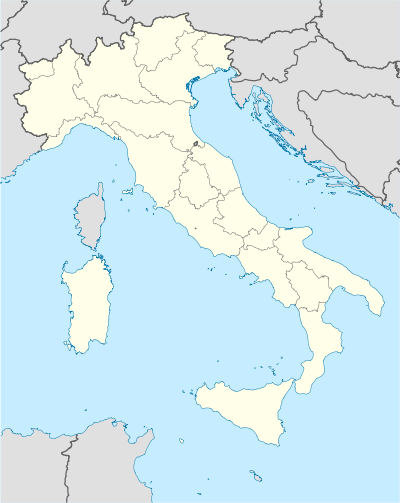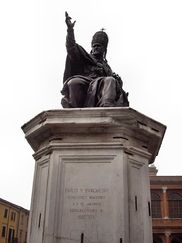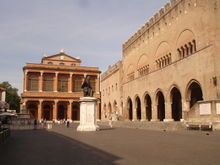Rimini
| Rimini | |
|---|---|
| — Comune — | |
| Comune di Rimini | |
|
|
|
 Rimini
|
|
| Coordinates: | |
| Country | Italy |
| Region | Emilia-Romagna |
| Province | Rimini (RN) |
| Frazioni | Bellariva, Corpolò, Marebello, Miramare di Rimini, Rivabella, Rivazzurra, San Fortunato, San Giuliano a Mare, San Vito, Santa Aquilina, Santa Giustina, Torre Pedrera, Viserba, Viserbella |
| Government | |
| - Mayor | Alberto Ravaioli (Democratic Party) |
| Area | |
| - Total | 134 km2 (51.7 sq mi) |
| Elevation | 6 m (20 ft) |
| Population (21 December 2009) | |
| - Total | 141,056 |
| - Density | 1,052.7/km2 (2,726.4/sq mi) |
| Demonym | Riminesi |
| Time zone | CET (UTC+1) |
| - Summer (DST) | CEST (UTC+2) |
| Postal code | 47921, 47922, 47923, 47924 |
| Dialing code | 0541 |
| Patron saint | St. Gaudentius |
| Saint day | October 14 |
| Website | Official website |
Rimini listen (Italian pronunciation: [ˈri(ː)mini]) is a city and comune in the Emilia-Romagna region of Italy and capital city of the Province of Rimini. It is located on the Adriatic Sea, near the coast between the rivers Marecchia (the ancient Ariminus) and the Ausa River (Aprusa). Coast navigation and fishing are traditional industries and, together with Riccione, it is probably the most famous seaside resort on the Adriatic Riviera.
Contents |
History
Ancient history

In 268 BC at the mouth of the Ariminus river, in an area that had previously been inhabited by the Etruscans, the Umbrians, the Greeks and the Gauls, the Romans founded the colony of Ariminum, probably from the name of a nearby river, Ariminus (today, Marecchia). It was seen as a bastion against invading Gaul and also as a springboard for conquering the Padana plain. Rimini was a road junction connecting central Italy (Via Flaminia) and northern Italy (Via Aemilia that led to Piacenza and Via Popilia) and it also opened up trade by sea and river.
In the sixth century BC, it was taken by the Gauls; after their last defeat (283 BC), it returned to the Umbri and became in 263 BC a Latin colony, very helpful to the Romans during the late Gallic wars.
The city was involved in the civil wars but remained faithful to the popular party and to its leaders, firstly Marius and then Caesar. After crossing the Rubicon, the latter made his legendary appeal to the legions in the Forum of Rimini.
Rimini drew the attention of many Roman emperors, including Augustus who did much for the city and Hadrian in particular. This great period in its history was embodied by the construction of prestigious monuments such as the Arch of Augustus, Tiberius' Bridge and the Amphitheatre and Galla Placida built the church of San Stefano.
Crisis in the Roman world was marked by destruction caused by invasions and wars, but also by the testimony of the palaces of the Imperial officers and the first churches, the symbol of the spread of Christianity that held an important Council in Rimini in 359.
Middle Ages

When the Goths conquered Rimini in 493, Odoacer, besieged in Ravenna, had to capitulate. During the Gothic War Rimini was taken and retaken many times. In its vicinity the Byzantine general Narses overthrew (553) the Alamanni. Under Byzantine dominion it belonged to the Pentapolis, part of the Exarchate of Ravenna.
In 728 it was taken with many other cities by the Lombard King Liutprand but returned to the Byzantines about 735. King Pepin gave it to the Holy See, but during the wars of the popes and the Italian cities against the emperors, Rimini sided with the latter.
In the thirteenth century it suffered from the discords of the Gambacari and Ansidei families. The city became a municipality in the fourteenth century and with the arrival of the religious orders, numerous convents and churches were built, providing work for many illustrious artists. In fact, Giotto inspired the fourteenth-century School of Rimini, which was the expression of original cultural ferment.
The Malatesta family emerged from the struggles between municipal factions with Malatesta da Verucchio, who in 1239 was named podestà (feudal lord) of the city. Despite interruptions, his family held authority until 1528. In 1312 he was succeeded by Malatesta II, first signore (lord) of the city and Pandolfo I, the latter's brother, named by Louis the Bavarian imperial vicar in Romagna. Ferrantino, son of Malatesta II (1335), was opposed by his cousin Ramberto and by Cardinal Bertando del Poggetto (1331), legate of John XXII. Malatesta III, Guastafamiglia (1363), was also lord of Pesaro. He was succeeded by Malatesta IV l'Ungaro (1373) and Galeotto, uncle of the former (1385), lord also of Fano (from 1340), Pesaro, and Cesena (1378).
His son Carlo, one of the most respected condottieri of the time, enlarged the Riminese possessions to Lombardy and restored the port. Carlo died childless in 1429, and the lordship was divided into three parts, Rimini going to Galeotto Roberto, a Catholic zealot who turned out to be totally inadequate for the role. The Pesarese line of the Malatestas tried, in fact, to take advantage of his weakness and to capture the city, but Sigismondo Pandolfo Malatesta, Carlo's nephew, who was only 14 at the time, intervened to save it. Galeotto retired to a convent, and Sigismondo obtained the rule of Rimini.
Sigismondo Pandolfo was the most famous lord of Rimini. In 1433 Emperor Sigismund soujourned in the city and for a while he was the commander-in-chief of the Papal armies. A skilled general, Sigismondo often acted as condottiero for other states to gain money to embellish it (he was also a dilettante poet). He had the famous Tempio Malatestiano rebuilt by Leon Battista Alberti. However, after the rise of Pope Pius II he had to fight constantly for the independence of the city. In 1463 he was forced to submit to Pius II, who left him only Rimini and little more; Roberto Malatesta, his son (1482), under pope Paul II nearly lost his state but under Sixtus IV became the commanding officer of the pontifical army against Ferdinand of Naples. Sigismondo was, however, defeated by Neapolitan forces in the battle of Campomorto (1482). Pandolfo IV, his son (1500), lost Rimini to Cesare Borgia, after whose overthrow it fell to Venice (1503–1509), but it was later retaken by pope Julius II and incorporated into the Papal States. After the death of pope Leo X, Pandolfo returned for several months, and with his son Sigismondo held a rule which looked tyrannous even for the time. Pope Adrian VI expelled him again and gave Rimini to the Duke of Urbino, the pope's vicar in Romagna. In 1527 Sigismondo managed to regain the city, but in the following year the Malatesta dominion died forever.
Modern history

At the beginning of the 16th century, Rimini, now a secondary town of the Papal States, had a local government under an Apostolic Legate (temporal governor in a province of the Papal States). Towards the end of the 16th century, the municipal square (Piazza Cavour), which had been closed off on a site where the Poletti Theatre was subsequently built, was redesigned. The statue of Pope Paul V has stood in the centre of the square next to the fountain since 1614.
In the 16th century, the 'grand square' (now the Piazza Tre Martiri in honor of three civilians hanged by the retreating Nazis at the end of World War II), which was where markets and tournaments were held, underwent various changes. For example, a small temple dedicated to Saint Anthony of Padua and the Clock Tower block were built, giving the square its present shape and size.
Until the 18th century, raiding armies, earthquakes, famines, floods and pirate attacks ravaged the city. In this gloomy situation and due to a weakened local economy, fishing took on great importance, a fact testified by the construction of functional structures such as the fish market and the lighthouse.
In 1797, Rimini, along with the rest of Romagna, was influenced by the passage of the French troops and became part of the Cisalpine Republic. The Napoleonic government suppressed the monastic orders, confiscating their property and thus dispersing a substantial heritage, and demolished many churches including the ancient cathedral of Santa Colomba. On 30 March 1815, Joachim Murat launched his proclamation to the Italian people from Rimini, inciting them to unity and independence. In 1845 a band of adventurers commanded by Ribbotti entered the city and proclaimed a constitution which was soon abolished. In 1860 Rimini and the Romagna were incorporated with the Kingdom of Italy.
An idea of what the city was like in the 19th century is provided by the palaces built along Corso Augusto and in particular by the theatre, which was designed by Luigi Poletti and succeeded in translating into Neoclassical form the ambitions of the ruling classes.
However, the biggest revolutionary element for the city was the foundation in 1843 of the first bathing establishment and the Kursaal, constructed to host sumptuous social events, became the symbol of tourist Rimini. In just a few years, the marina underwent considerable building work making Rimini 'the city of small villas'. At the beginning of the twentieth century, The Grand Hotel, the city’s first important accommodation facility, was built near the coast and soon became the emblem of a new kind of tourism.
During the first World War, Rimini and its surrounding infrastructure was one of the primary targets of the Austro-Hungarian Navy. After Italy's declaration of war on 15 May 1915 the imperial fleet left its harbors the same day and started its assault on the eastern Italian coast between Venice and Barletta.
During World War II, the city was torn apart by heavy bombardments and by the passage of the front along the Gothic Line, and it was eventually captured by Greek and Canadian forces. Following its liberation on September 21, 1944, impressive reconstruction work began, culminating in the explosive development of the tourist economy that created a new urban reality.
Main sights


- The 13th century cathedral (San Francesco, best known as Tempio Malatestiano) was originally in Gothic style, but was transformed by order of Sigismondo Pandolfo Malatesta according to the designs of Leon Battista Alberti and never completed. In the cathedral are the tombs of Sigismondo and his wife Isotta.
There is also tomb of last Byzantine and first new-Greek philosoph Georgios Gemistos-Plithon
- The Arch of Augustus. Built in 27 BC, it has a single gate 9.92 m (32.55 ft) high and 8.45 m (27.72 ft) wide. The merlons were added in the Middle Ages. It was restored in the 18th century by Tommasso Temenza.
- the church of San Giuliano Martire (1553–1575), housing the great picture of Paul Veronese (1588) representing the martyrdom of that saint. It includes also pictures of Bittino da Faenza (1357) dealing with some episodes of the saint's life (1409).
- The Tiberius Bridge. As the inscription on the internal parapets recalls, the bridge over the Marecchia River, then known as Ariminus, began under Augustus in 14 AD and was completed under Tiberius in 21. The bridge still connects the city centre to Borgo San Giuliano and leads to the consular roads Via Emilia and Via Popilia that lead north. Built in Istria stone, the bridge consists of five arches that rest on massive pillars with breakwater spurs set at an oblique angle with respect to the bridge’s axis in order to follow the current. The bridge’s structure on the other hand, rests on a practical system of wooden poles.
- The Roman amphitheater (2nd century). It was erected alongside the ancient coast line, and had a two orders of porticoes with 60 arcades. It had elliptical shape, with axes of 117,7 x 88 meters. The arena measured 73 x 44 meters, not far from the greatest Roman amphitheatres: the edifice could house up to 15,000 spectators.
- The Castel Sismondo or Rocca Malatestiana of Sigismondo Pandolfo was later used as a prison.
- Palazzo dell'Arengo e del Podestà (1204), seat of the judiciary and civil administrations. On the short side in the 14th century the podestà residence was added. It was modified at the end of the 16th century.
- Teatro Galli: The Rimini theatre, originally dedicated to the king Vittorio Emanuele II and then to the musician Amintore Galli, is the work of the architect Luigi Poletti. It was inaugurated in 1857 with an Opera by Giuseppe Verdi (Aroldo). The theatre was bombed during the WWII. Since then it is still a ruin in the city centre. Many projects and plans have been made to restore it during the years, the last has been recently announced (2010)([Teatro Galli: un progetto per un teatro vivo]);
- The church of St. John the Evangelist (also known as St. Augustine)
- The church of San Giovanni Battista, erected in the 12th century. It has a single nave with rich stucco decoration from the 18th century.
- The town hall has a small but valuable gallery (Perin del Vaga, Ghirlandajo, Bellini, Benedetto Coda, Tintoretto, Agostino di Duccio); the Gambalunga Library (1677) has valuable manuscripts.
- Church of San Fortunato (1418). It houses the Adoration of the Magi (1547) by Giorgio Vasari.
- The bell tower of the former Cathedral of Santa Colomba.
- Archeological museum.
- Bronze statue of Paul V.
Transportation
Rimini is provided with six railway stations (Rimini, Rimini Fiera, Rimini Miramare, Rimini Rivazzurra, Rimini Viserba and Rimini Torre Pedrera).
It is served by the Federico Fellini Airport, airport of Rimini and San Marino.
International relations
Twin towns — sister cities
Rimini is twinned with:
|
|
See also
- Bishopric of Rimini
- Rimini Calcio Football Club
- Battle of Rimini (1944)
- The Grand Hotel Rimini
- Federico Fellini
Sources and external links
- Rimini travel guide from Wikitravel
- Province of Rimini
- Rimini Comune (Town Council)
- Rimini Tourist Board website
- International Airport of Rimini
- Blog Rimini: a blog devoted to Rimini Tourism
|
|||||||
